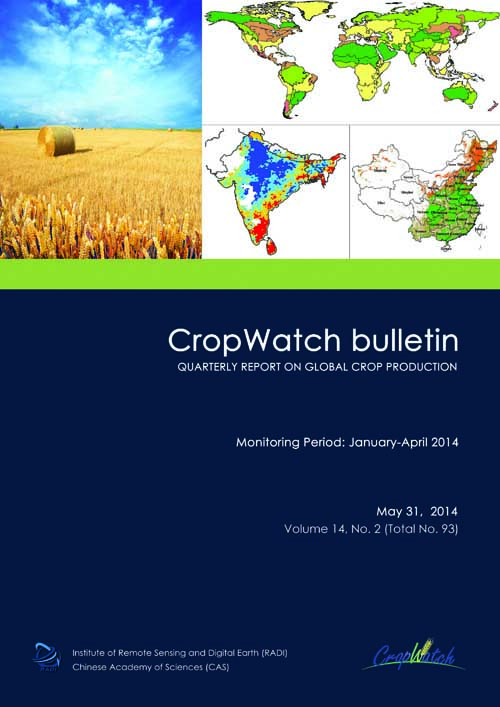
-
The May 2014 CropWatch bulletin (Vol. 14, No. 2) summarizes global crop condition developments and agroclimatic factors from January to April 2014, focusing on key crop producing and exporting areas and China. The bulletin reports on cold spells, warm spells, and droughts affecting large areas, with resulting impacts on regional and national agricultural production. Findings also include that some of the observed climatic anomalies are in line with El Niño induced weather patterns. The report lists current production estimates for maize, rice, wheat, and soybean for calendar year 2014, using CropWatch information on crop condition and areas of cropped land compared to recent years. The bulletin’s special focus is on disasters, wheat, and El Niño.
Key messages from the report:
- Several large scale weather anomalies—cold spells, warm spells, and droughts--dominating the reporting period, although no major disasters seriously affected agriculture.
- Cold conditions occurred in two large areas, including (i) most of Canada and the eastern-central United States, and (ii) a large area including Punjab to Gujarat, the Pamir mountains, and adjacent central Asian countries.
- Recent temperature patterns captured by CropWatch indicators are compatible with El Niño induced weather pattern.
- For China, overall conditions for the country can be described as average, but large regional differences are observed over the monitoring period.
- The fractions of cropped arable land in both the Loess region and the North-East region in China increased in excess of 10 percentage points.
- Record crops of maize are expected in South Africa and Mexico (close to a 7% increase), while the output in Brazil and Argentina is best described as average (+0.3% and +0.9%).
Introduction and quick reference guide
This CropWatch bulletin summarizes global crop condition developments and agroclimatic factors from January to April 2014, focusing on key crop producing and exporting areas and China. The bulletin is prepared by the Institute of Remote Sensing and Digital Earth, Chinese Academy of Sciences in Beijing. The first part of the report includes the table of contents, abbreviations, and a handy quick reference guide to the indicators and spatial units used throughout the bulletin.DownloadChapter 1. Global agroclimatic patterns
Chapter 1 describes the CropWatch agroclimatic indicators—RAIN, TEMP, and RADPAR—along with the agronomic indicator BIOMASS for sixty-five global Crop Production System Zones (CPSZ). The presented global overview of relatively wet or dry, warm or cold conditions provides the background for subsequent analysis in Chapters 2, 3 and 4. Overall, the current reporting period is characterized by a number of large areas undergoing abnormal conditions.DownloadChapter 2. Crop and environmental conditions in major production zones
Chapter 2 presents the same indicators—RAIN, TEMP, RADPAR, and BIOMASS—used in Chapter 1, and combines them with the agronomic indicators—cropped arable land fraction (CALF), maximum vegetation condition index (VCIx), and vegetation health index (VHI)—to describe crop condition in seven Major Production Zones (MPZ) across all continents. The findings generally substantiate some extreme conditions already presented in the first chapter, providing additional detail on the timing of weather events, agricultural impacts, and their spatial patterns.DownloadChapter 3. Main producing and exporting countries
Building on the global patterns presented in previous chapters, this chapter assesses in detail the situation of crops in 30 key countries that represent the global major producers and exporters. For each individual country, maps present maximum VCI, spatial NDVI patterns, associated NDVI profiles, and an NDVI-based crop condition development graph. For additional detail on the agroclimatic and BIOMASS indicators, in particular for some of the larger countries, see also the tables A.2-A.10 in Annex A.DownloadChapter 4. China
Chapter 4 presents a detailed CropWatch analysis for China, focusing on the seven most productive agro-ecological regions of the east and south. After a brief overview, detailed analysis including maps and profiles for NDVI, VCI, CALF, and BIOMASS are provided for the individual regions. While overall crop condition for China is mostly average, large regional differences are observed. Additional information on the agroclimatic indicators by Chinese province are provided in table A.11 in Annex A.DownloadChapter 5. Focus and perspectives
This focus section complements CropWatch analyses presented in chapters 1 through 4 by presenting topics of relevance to global agriculture. After a summary of the provisional CropWatch estimates for 2014 production in section 5.1, section 5.2 highlights the extreme atmospheric factors—disaster events—that have interfered with crop production over the monitoring period. Next, sections 5.3 and 5.4 focus on the future of wheat and El Niño.DownloadAnnex A. Agroclimatic indicators
Tables in this Annex provide additional information about the agroclimatic indicators for the Crop Production System Zones; thirty-one main producing and exporting countries; regions or provinces within large countries—Argentina, Australia, Brazil, Canada, India, Kazakhstan, Russia, and the United States; and China.DownloadAnnex B. 2014 Production estimates
2014 Production estimates for Argentina, Brazil, and the United States.Download

